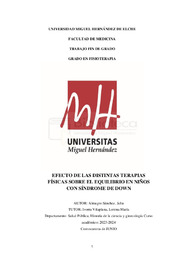Please use this identifier to cite or link to this item:
https://hdl.handle.net/11000/33524Full metadata record
| DC Field | Value | Language |
|---|---|---|
| dc.contributor.advisor | Ivorra Vilaplana, Lorena María | - |
| dc.contributor.author | Almagro Sánchez, Julia | - |
| dc.contributor.other | Departamentos de la UMH::Salud Pública, Historia de la Ciencia y Ginecología | es_ES |
| dc.date.accessioned | 2024-10-16T12:05:05Z | - |
| dc.date.available | 2024-10-16T12:05:05Z | - |
| dc.date.created | 2024-06-03 | - |
| dc.identifier.uri | https://hdl.handle.net/11000/33524 | - |
| dc.description.abstract | Introducción: El síndrome de Down (SD) es un trastorno genético causado por la presencia de un cromosoma 21 extra. Con una incidencia de 1 por cada 1000 niños nacidos vivos a nivel mundial. Las personas con SD presentan ciertos rasgos físicos y motores característicos, como hipotonía muscular, hiperlaxitud y una baja fuerza y resistencia muscular. Objetivos: El objetivo principal es determinar la eficacia de las distintas terapias de fisioterapia sobre el equilibrio en niños con SD. Así como describir las escalas más frecuentemente utilizadas para la evaluación del equilibrio y nuevas tecnologías que pueden ser utilizadas para la adquisición de nuevas habilidades motoras. Material y método: Se ha realizado una búsqueda bibliográfica utilizando Pubmed y bases de datos EMBASE, Scopus y Cochrane Library. Se han seleccionado ensayos clínicos publicados en los últimos 10 años, la población a estudio son niños con SD, entre los 3-18 años y estuvieran en inglés o en español. Excluyendo aquellos artículos que no cumplieran con estos criterios. Resultados: Se incluyeron 7 estudios con entrenamientos enfocados en una mejora del equilibrio en niños con SD. Como es el entrenamiento vestibular o Pilates, entre otros. Los cuatro métodos de medición del equilibrio descritos son el sistema BIODEX, el software ROMBERGLAB, el sistema BOT-2 y la escala Berg. En [5,11,18] artículos se encontraron mejoras significativas en los tres índices de equilibrio evaluados. Conclusiones: El tratamiento fisioterapéutico en combinación con las terapias físicas estudiadas mejoran el equilibrio en niños con SD. | es_ES |
| dc.description.abstract | Introduction: Down syndrome (DS) is a genetic disorder caused by the presence of an extra chromosome 21. With an incidence of 1 per 1000 live births worldwide. People with DS present certain characteristic physical and motor features, such as muscle hypotonia, hypermobility, and low muscle strength and endurance. Objective: The main objective is to determine the effectiveness of different physiotherapy therapies on balance in children with DS. As well as describing the most frequently used scales for the evaluation of balance and new technologies that can be used for the acquisition of new motor skills. Material and methods: A bibliographic search was carried out using Pubmed and EMBASE, Scopus and Cochrane Library databases. Clinical trials published in the last 10 years have been selected. The study population is children with DS, between 3-18 years old and they were in English or Spanish. Excluding those articles that did not meet these criteria. Results: Seven studies were included with training focused on improving balance in children with DS. Such as vestibular training or Pilates, among others. The four balance measurement methods described are the BIODEX system, ROMBERGLAB software, the BOT-2 system, and the Berg scale. In [5,11,18] articles, significant improvements were found in the three balance indices evaluated. Conclusion: Physiotherapeutic treatment in combination with the physical therapies studied improve balance in children with DS. | es_ES |
| dc.format | application/pdf | es_ES |
| dc.format.extent | 31 | es_ES |
| dc.language.iso | spa | es_ES |
| dc.publisher | Universidad Miguel Hernández | es_ES |
| dc.rights | info:eu-repo/semantics/openAccess | es_ES |
| dc.rights.uri | http://creativecommons.org/licenses/by-nc-nd/4.0/ | * |
| dc.subject | Fisioterapia | es_ES |
| dc.subject | Terapia física | es_ES |
| dc.subject | Síndrome de Down | es_ES |
| dc.subject | niños | es_ES |
| dc.subject | Equilibrio | es_ES |
| dc.subject.other | CDU::6 - Ciencias aplicadas | es_ES |
| dc.title | Efecto de las distintas terapias física sobre el equilibrio en niños con Síndrome de Down | es_ES |
| dc.type | info:eu-repo/semantics/bachelorThesis | es_ES |

View/Open:
TFG ALMAGRO SÁNCHEZ JULIA.pdf
665,28 kB
Adobe PDF
Share:
.png)
